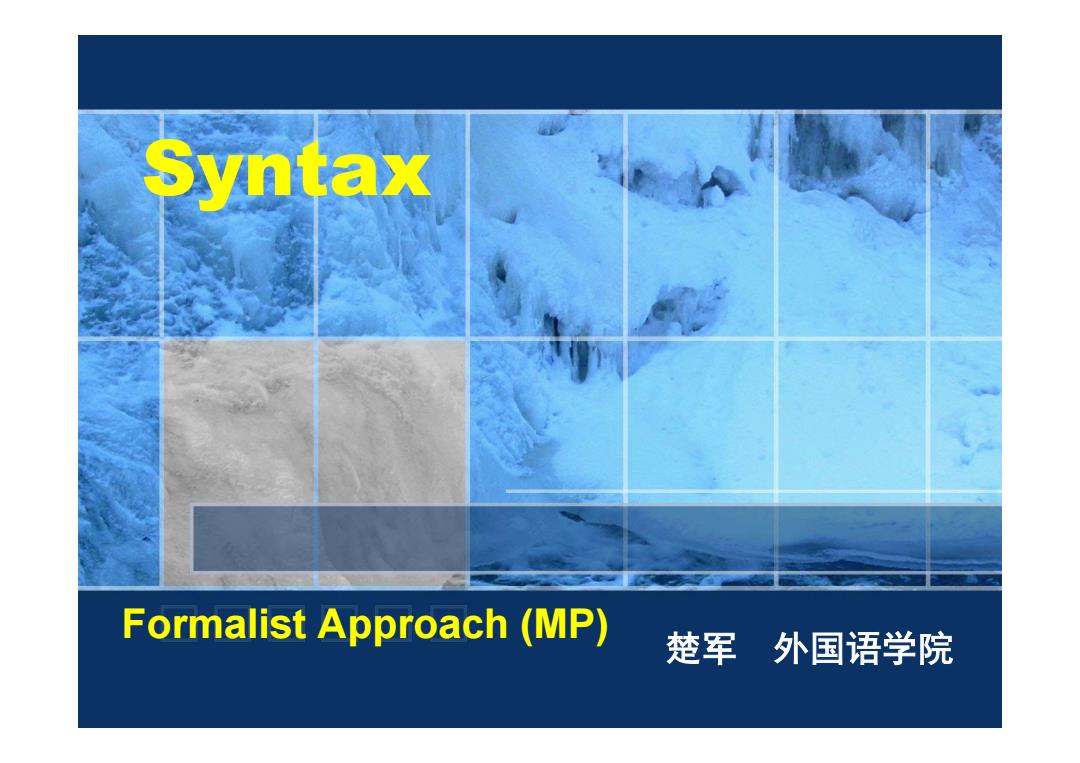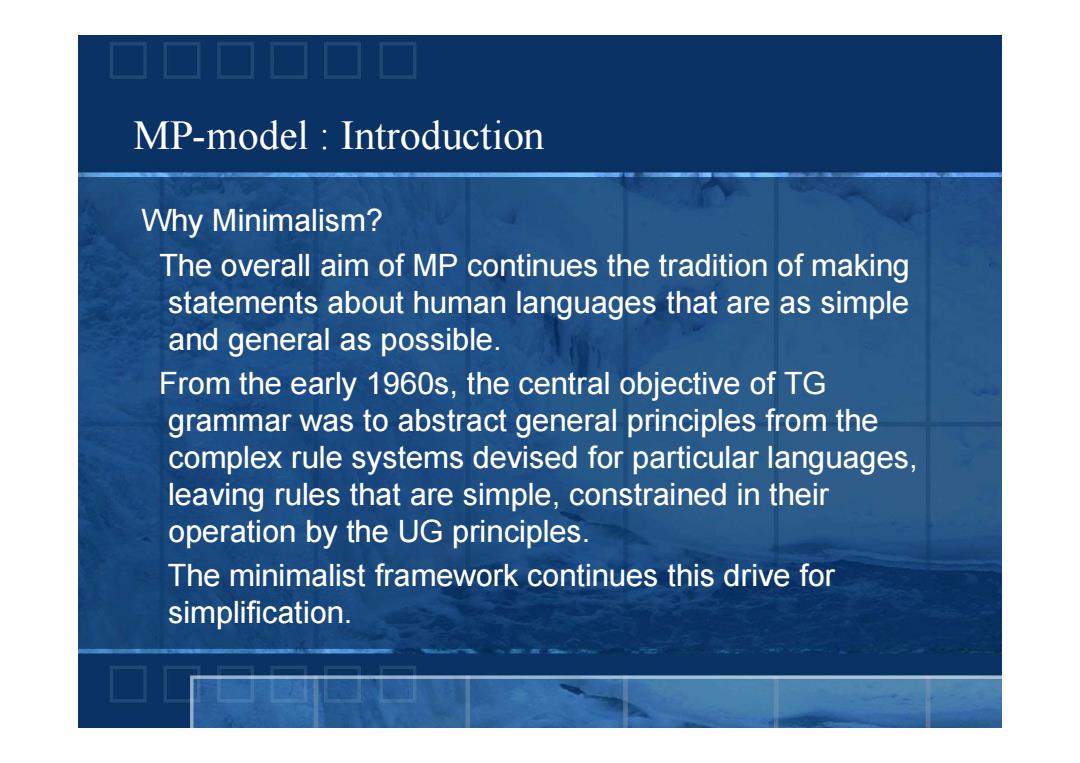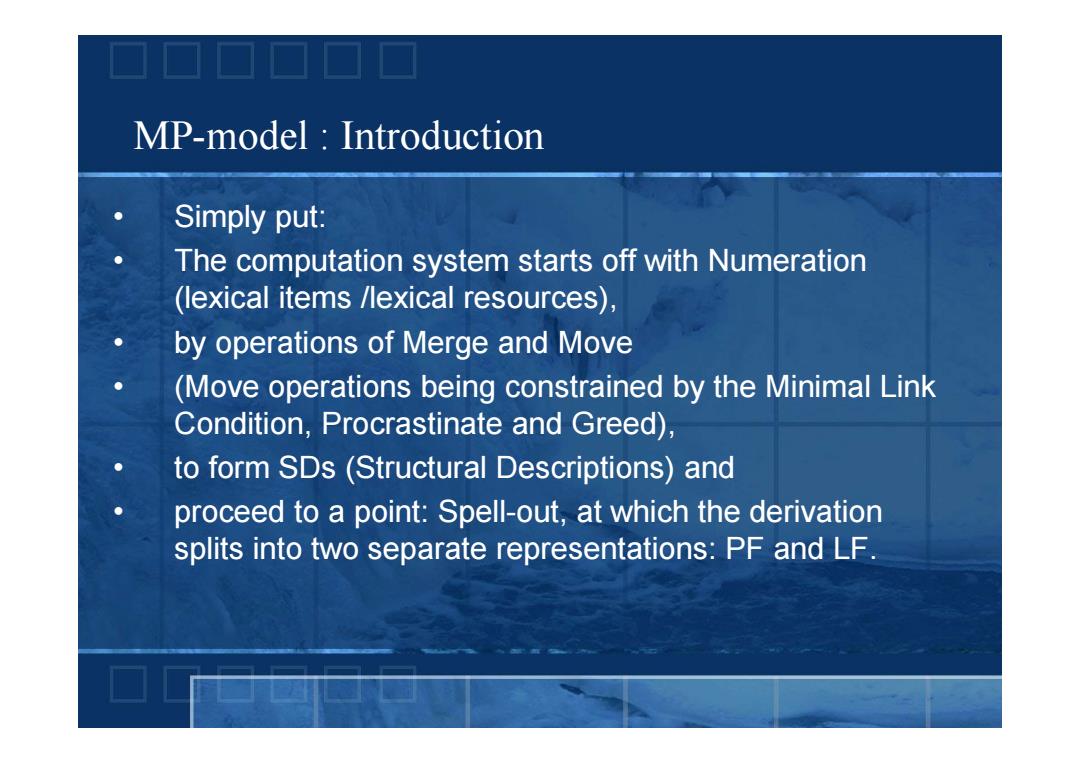
Syntax Formalist Approach(MP) 楚军外国语学院
Formalist Approach (MP) 楚军 外国语学院 Syntax

MP-model Introduction Why Minimalism? The overall aim of MP continues the tradition of making statements about human languages that are as simple and general as possible. From the early 1960s,the central objective of TG grammar was to abstract general principles from the complex rule systems devised for particular languages, leaving rules that are simple,constrained in their operation by the UG principles. The minimalist framework continues this drive for simplification
MP-model : Introduction Why Minimalism? The overall aim of MP continues the tradition of making statements about human languages that are as simple and general as possible. From the early 1960s, the central objective of TG grammar was to abstract general principles from the complex rule systems devised for particular languages, leaving rules that are simple, constrained in their operation by the UG principles. The minimalist framework continues this drive for simplification

MP-model Introduction The defining characteristic of MP model: --if the linguistic system needs to be as economical as possible,in terms of both how it represents and generates structures,clearly the smallest possible set of devices to account for language phenomena should be used
MP-model : Introduction The defining characteristic of MP model: --if the linguistic system needs to be as economical as possible, in terms of both how it represents and generates structures, clearly the smallest possible set of devices to account for language phenomena should be used

MP-model Introduction As for the famous upside-down T-model (p.96 (③),MP questions whether all the levels of representation are really necessary. ● Since language is a mapping between sound and meaning,the only absolutely necessary representations are at the interfaces of the meaning and sound components of the linguistic system where language connects,on the one hand to the physical world of sounds,on the other to the mental world of cognition
MP-model : Introduction • As for the famous upside-down T-model (p.96 (3)), MP questions whether all the levels of representation are really necessary. • Since language is a mapping between sound and meaning, the only absolutely necessary representations are at the interfaces of the meaning and sound components of the linguistic system where language connects, on the one hand to the physical world of sounds, on the other to the mental world of cognition

MP-model Introduction In MP model,only LF and PF are really necessary and there must be a lexicon and a computational system'which forms LF and PF representations from lexical information.Thus, D-and S-structure,together with 'government' and X-bar are done away with
MP-model : Introduction • In MP model, only LF and PF are really necessary and there must be a lexicon and a ‘computational system’ which forms LF and PF representations from lexical information. Thus, D- and S-structure, together with ‘government’ and X-bar are done away with

MP-model Introduction Numeration:a set of elements selected from the lexicon which is the starting point of the structure building process. Spell-out:the point in the derivation of a structure at which phonetically relevant information is separated from all other information.In this way two structures,an LF and a PF,are formed from a single Numeration
MP-model : Introduction • Numeration: a set of elements selected from the lexicon which is the starting point of the structure building process. • Spell-out: the point in the derivation of a structure at which phonetically relevant information is separated from all other information. In this way two structures, an LF and a PF, are formed from a single Numeration

MP-model Introduction Convergence: LF and PF representations must contain information of the relevant sort (semantic and phonetic respectively)in order to satisfy the Principle of Full Interpretation. If a representation at LF or PF conforms to Full Interpretation,it converges at that level. A whole derivation converges if it converges at both LF and PF.If not,it crashes and the structure is ungrammatical
MP-model : Introduction Convergence: • LF and PF representations must contain information of the relevant sort (semantic and phonetic respectively) in order to satisfy the Principle of Full Interpretation. • If a representation at LF or PF conforms to Full Interpretation, it converges at that level. • A whole derivation converges if it converges at both LF and PF. If not, it crashes and the structure is ungrammatical

MP-model Introduction Structure Building: Merge:the combinatorial process which forms structures from elements in the Numeration and other partially built structures. Move:the movement process which also plays a role in structure building-e.g.a specifier position will be created as part of the process of moving an element into it
MP-model : Introduction Structure Building: Merge: the combinatorial process which forms structures from elements in the Numeration and other partially built structures. Move: the movement process which also plays a role in structure building—e.g. a specifier position will be created as part of the process of moving an element into it

MP-model Introduction The Minimal Link Condition: a constraint on Move which prevents elements moving further than the nearest relevant position. Procrastinate:a general constraint on the computation which says delaying doing anything until it needs to be done. Greed:another constraint on the computation which says that processes only affect an element to satisfy the requirements of that element
MP-model : Introduction The Minimal Link Condition: a constraint on Move which prevents elements moving further than the nearest relevant position. Procrastinate: a general constraint on the computation which says delaying doing anything until it needs to be done. Greed: another constraint on the computation which says that processes only affect an element to satisfy the requirements of that element

MP-model Introduction Simply put: The computation system starts off with Numeration (lexical items /lexical resources), by operations of Merge and Move ● (Move operations being constrained by the Minimal Link Condition,Procrastinate and Greed), to form SDs(Structural Descriptions)and proceed to a point:Spell-out,at which the derivation splits into two separate representations:PF and LF
MP-model : Introduction • Simply put: • The computation system starts off with Numeration (lexical items /lexical resources), • by operations of Merge and Move • (Move operations being constrained by the Minimal Link Condition, Procrastinate and Greed), • to form SDs (Structural Descriptions) and • proceed to a point: Spell-out, at which the derivation splits into two separate representations: PF and LF